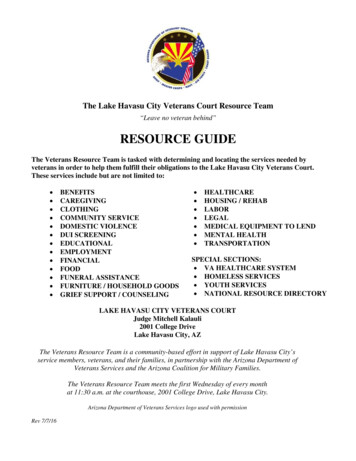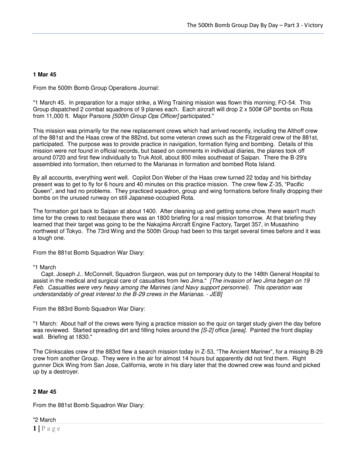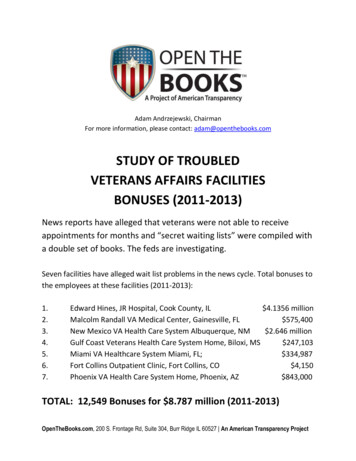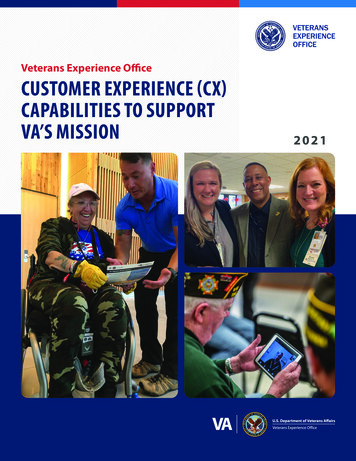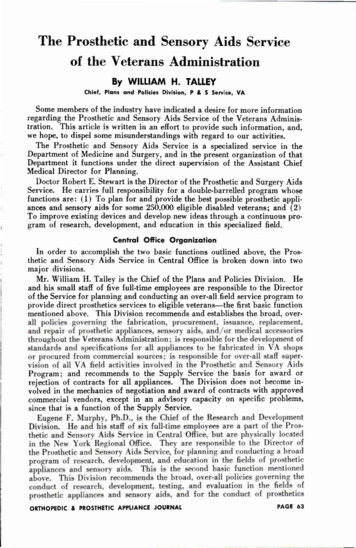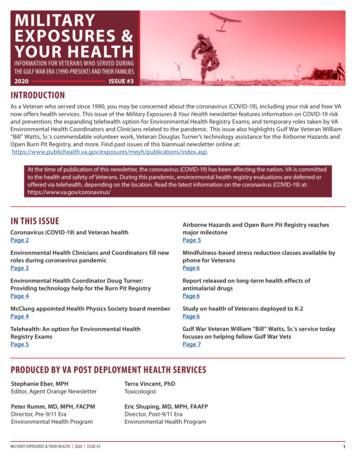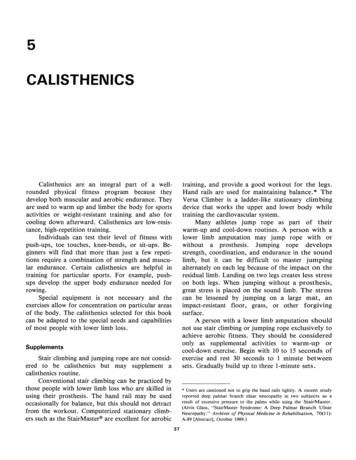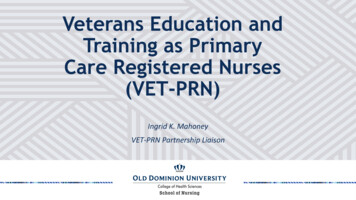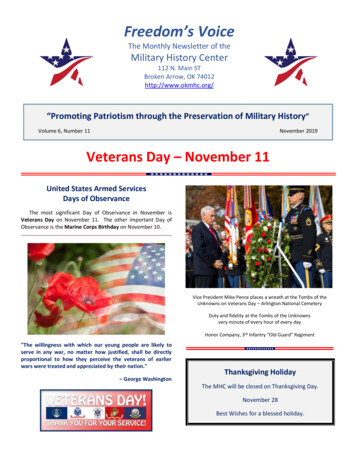
Transcription
Freedom’s VoiceThe Monthly Newsletter of theMilitary History Center112 N. Main STBroken Arrow, OK 74012http://www.okmhc.org/“Promoting Patriotism through the Preservation of Military History”Volume 6, Number 11November 2019Veterans Day – November 11United States Armed ServicesDays of ObservanceThe most significant Day of Observance in November isVeterans Day on November 11. The other important Day ofObservance is the Marine Corps Birthday on November 10.Vice President Mike Pence places a wreath at the Tombs of theUnknowns on Veterans Day – Arlington National CemeteryDuty and fidelity at the Tombs of the Unknownsvery minute of every hour of every dayHonor Company, 3rd Infantry “Old Guard” Regiment"The willingness with which our young people are likely toserve in any war, no matter how justified, shall be directlyproportional to how they perceive the veterans of earlierwars were treated and appreciated by their nation."– George WashingtonThanksgiving HolidayThe MHC will be closed on Thanksgiving Day.November 28Best Wishes for a blessed holiday.
Salute to Veterans ConcertOn Sunday, November 10, the MHC presented its fourthannual Salute to Veterans Concert at Kirkland Auditorium inBroken Arrow. BG Tom Mancino (U.S. Army, Ret.), President ofthe MHC, served as master of ceremonies. The event wasopened by the Broken Arrow High School JROTC Color Guardposting the colors. Dr. Clarence Oliver offered the invocation.Maggie Bond, Miss Broken Arrow-2019, then sang two popularsongs of the World War II period.Mr. Johnny ParksBroken Arrow High School JROTC Color Guardpresenting the colorsMr. Johnny Parks, a Broken Arrow City Councilor and Armyveteran of the Vietnam Era, gave an address on his experiencesas a member of the Honor Company of the 3rd Infantry “OldGuard” Regiment.The concert was presented by Tulsa Community Band under the direction of Principal Conductor Martha Kramer, Assistant Conductor JoAnn Johnson and Associate Conductor PamTerhune. Tulsa Community Band was organized in 1938 as theAmerican Legion Band. The Band currently has eighty-fivemembers, both professional and amateur. They performthroughout northeast Oklahoma. The Band played numerouspatriotic pieces during the concert and was a big hit with theconcert attendees.World War II veteran, Frank Riesinger, guest conducted theband playing “Stars and Stripes Forever”. The concert wasclosed with Ms. Bond singing “Amazing Grace” and “God BlessAmerica”. BG Mancino closed the event by recognizing theveterans in attendance by the periods of their service – WorldWar II to the present. Altogether, it was a superb event, arguably the best one yet.The Tulsa Community Band presents Frank Riesingerwith an appreciation awardTulsa Community Band – Ms. Kramer conducting
MHC BirthdayMHC docent, Dennis Hoch, accompanied Ms. Maggie Bondsinging “Amazing Grace”.On November 9, the MHC celebrated its sixth birthday. Thecore of the Museum’s collection was assembled over manyyears by Col. Robert W. Powell (USAF, Ret.). For several years,he displayed his collection at Memorial High School in Tulsaand later in a Tulsa office building. At the June 2013 Flag Dayevent, he deeded his large collection to the Military HistoryMuseum. With the transfer of ownership of the collection andoccupancy of the newly rehabilitated building at 112 N. MainStreet, the Museum was anxious to get going. The collectionwas moved and setup at the new location. On November 9,2013, the Museum was officially opened with a grand openhouse, attended by an estimated 200 guests.Since then, the Museum’s name has been changed to Military History Center. In the meantime, the collection has growntremendously, as veterans or their families have generouslydonated their personal artifacts or collections. However, ourmission – “Promoting Patriotism through the Preservation ofMilitary History” – remains unchanged. We are grateful to allwho have supported the MHC.Support the Military History CenterMHC volunteers, Claudia Price and Susan Virdell, and ExecutiveAssistant, JeanE Bailie at the information tableThe MHC extends the sincerest “thank you” to everyonewho came out to take part in this special event honoring ourveterans and enjoying a fabulous concert of patriotic music.We also thank all the volunteers who assisted with the event. Avery special “thank you” goes out to MBS, Incorporated (MetroAppliances & More and Hahn Appliances) for sponsoring theconcert and for all those businesses that purchased advertisements in the program. We salute MHC Board member, KeithBrowne, who put together the exceptional event.Remember AmazonSmile, when you do your Christmasshopping.AmazonSmile enables shoppers to select a charity towhich Amazon will contribute a small percentage of a shopper’s purchase. To take advantage of the program, sign onto AmazonSmile and select “Military History Center BrokenArrow” as the charity you want to support.When you shop, you MUST log onto AmazonSmile toreceive the benefits of the program. If you logon and shopat regular Amazon, no money will be paid to your charity.To date, Amazon has contributed more than 100 millionto the program. So, if you haven’t already done so, go toAmazonSmile now, designate MHC as your favorite charityand begin shopping.
Rose District Veterans BannersThe Military History Center and Blue Star Mothers of America have sponsored seventy banners honoring local veteransduring 2019 Veterans Day. The banners are installed on lampposts in Broken Arrow’s Rose District. Banners honoring COLRobert W. Powell (Air Force – World War II and Korea), founderof the MHC, and SSGT Paul Collins (Army – World War II) areinstalled on lamp posts in front of the MHC.Anyone interested in having a future Memorial Day bannerfor a family member, contact BG Tom Mancino at (918) 7942712 for details.Royce Caskey, DAV Service Officer,Honored at the MHCOn November 7, Oklahoma Lieutenant Governor Matt Pinnell and Mr. Brian O’Hara from Oklahoma First District Congressman Kevin Hern’s office presented DAV Counselor RoyceCaskey with Oklahoma and Congressional Certificates of Appreciation for his continued years of service assisting veterans.Broken Arrow City Councilor and MHC Board member, DebraWimpee, Broken Arrow City Manager Michael Spurgeon, Broken Arrow Community Liaison and MHC Board member, Jennifer Sweezy, were among the distinguished guests at thepresentation. Mr. Caskey works out of the veteran’s serviceoffice located within the MHC.Ms. Debra Wimpee, Lieutenant Governor Matt Pinnell, Royce Caskey,City Manager Michael Spurgeon and Mr. Brian O’HaraLT Governor Pinnell, Royce Caskey, his daughter, Debbie, granddaughter, Isabella, and son-in-law, David Rollandini
Meet the DocentsJohn Samuel CroftMatthew Edward McHaneyMatthew Edward “Matt” McHaney was born at Casper,Wyoming, on December 30, 1963. He grew up in Denver andgraduated from Pomona High School in 1982. He joined theArmy in 1983. He was trained as an infantry rifleman and laterwon his parachutist’s wings. Much of his military service wasinvolved in the War on Drugs. He served with 3rd BN, 327th Infantry Regiment, 101st Airborne Division as a military policemanin El Salvador, Nicaragua, Honduras and Panama. The 3/327 IRwas part of Joint Task Force-Bravo, which operated out of SotoCano Air Base, Honduras, and was overseen by U.S. SouthernCommand. Their mission was to locate poppy fields and burnthem and to locate drug “factories” and destroy them. Mattseparated from the Army in 1990 as a staff sergeant.Matt was employed by the federal Bureau of Prisons at thefederal prison at Englewood, Colorado, during 1990-93. Afterwards, he worked as a bill collector for several firms. From2006 until his retirement, Matt worked for the Scott Lowreylaw office, a debt collection firm. In 2009, he was transferredto the firm’s Tulsa office as general manager. He retired inMarch 2019.Matt has been an MHC docent since August 2019. He livesin Broken Arrow.John Samuel Croft was born at Columbus, Ohio, on February 7, 1950. After graduation from Whitstone High School, heentered Ohio State University, where he graduated with aBachelor of Science degree in geology in 1972. He also wentthrough the Ohio State ROTC program and was commissioned afirst lieutenant in the Air Force upon graduation.John was sent to Columbus, Mississippi, for pilot training,but with the end of the Vietnam War, the Air Force had noneed for additional pilots. He was given a choice of severalother Air Force professions and selected Titan II missiles. Hewas sent to Shepherd AFB, Texas, to train as a missile combatcrew commander. After training, he was posted to VandenburgAFB, California, and later to McConnell AFB near Wichita, Kansas. During this time, his wing participated in the Olympic Arena Missile competition in California. In 1975, his wing won bestin the Strategic Air Command (SAC). In 1976, his missile command won best crew in SAC. John separated from the Air Forcein 1977 as a captain.While in the Air Force, John continued to work on his master’s degree, and in 1978, he received a Master of Science degree. John came to Tulsa in 1978 to work for Texaco. He laterworked for Unit Drilling and finally for Stratland Explorationfrom which, he retired in June 2018.John has been an MHC docent since December 2018. Helives in Broken Arrow.
This Month’s Featured ExhibitThe MHC’s newest exhibit is the Holocaust Exhibit. Artifacts include a schematic of the Dachau crematorium building and a SS guard’s helmet from Dachau (both on loan from the Sherman Miller Museum of Jewish Art), a reproduction Kapo armband such as worn by Jewish ghetto police or Kapos and a cap of the type worn by prisoners inconcentration and slave labor camps, (both on loan from John Jeffries), a leather cigarette case made by a formerDachau prisoner for SGT Paul Collins after the camp’s liberation (donated by Ken Collins), a pair of German strawoverboots made at the all-female slave labor camp at Ravensbrϋck (donated by Mary Beth Allen) and a Holocaustphoto album (created and donated by Ken Cook). We need many more Holocaust artifacts, so if anyone has anysuch artifacts or knows anyone who does, the MHC would be grateful if they could be donated for this exhibit.
Holocaust RetrospectiveOne of the pillars of Nazism was hatred of Jews. WithAdolph Hitler’s ascension to power as the chancellor of Germany in January 1933, Nazi anti-Jewish dogma became government policy. In the beginning, Hitler’s plan was for GermanJews to emigrate voluntarily. By the end of 1933, 65,000 hadleft. This was not fast enough nor in numbers acceptable toHitler. To get the Jews out of Germany faster, propaganda thatsystematically demonized them was increased and laws werepassed that removed Jews from German society, commerceand the professions relegating them to common laborers. Lawswere progressively enacted depriving Jews of their rights up toand including citizenship. Jews were commonly accosted onthe streets or in their homes, beaten and sometimes murdered. Jewish men were randomly arrested on any pretext andsent to Dachau, the first concentration camp constructed, within months of Hitler coming to power. It was intended primarilyto house so-called enemies of the state, not specifically forJews. However, tens of thousands of Jews were incarcerated atDachau. At first, those who survived were generally releasedafter a few months on the promise they would leave Germany.Hitler’s plan for voluntary Jewish emigration was only partially successful. In order to be allowed to leave Germany after1933, Jews had to forfeit all their property including real estate,financial investments, cash and personal property. This plungedthem into poverty. They were allowed to take only a tinyamount of cash and luggage out of Germany. The Nazis didn’tseem to realize this was counter-productive, or if they did, theydidn’t care. During the 1930s, Europe, the Americas, Australiaand many other countries were in the grip of the Great Depression. Countries were not interested in admitting povertystricken immigrants, who in many, if not most, cases would endup on welfare rolls. Moreover, many countries, including theUnited States and the United Kingdom had restrictive immigration laws at the time. The United States had passed the Johnson-Reed Act in 1924, which severely restricted immigrationand established country quotas. Germany’s quota was 25,957,increased to 27,370 in 1938 after Germany annexed Austria.About 523,000 Jews lived in Germany at the beginning of1933. When Germany closed emigration in October 1941,about 163,000 Jews remained in Germany, including Austria.Most would perish in the Holocaust. About 120,000 had beenable to settle in the United States, 52,000 in the United Kingdom. In France, Belgium and the Netherlands, about 30,000were accepted in each of the countries and about 55,000 wentto Palestine. Several thousand emigrated to countries in eastern Europe, where most were later caught up in the Holocaustand perished as did most of those who had settled in France,Belgium and the Netherlands. As the German army occupiedcountries in eastern Europe, millions of Jews came under German control. Emigration was no longer a viable solution.The Holocaust or Shoah (the Hebrew word for catastrophe)can be dated from June 22, 1941, with the German invasion ofthe Soviet Union. Before that date there had been no deportations or mass killings of Jews, and the Germans had not constructed, or even imagined, a single killing center. From thatdate, mass killings began in the Soviet Union, including annexedeastern Poland. By the end of 1941, around a million Jews hadbeen killed in the Soviet Union. Most were murdered by massshootings at killing pits throughout the German and Romanianoccupied areas. Before the year was over, mobile gas vans hadbeen introduced to supplement the shootings. By the end ofthe year, gassings had begun at the first Polish killing center atChelmno, and deportations from Ge
11.11.2019 · Appliances & More and Hahn Appliances) for sponsoring the concert and for all those businesses that purchased advertise-ments in the program. We salute MHC Board member, Keith Browne, who put together the exceptional event. MHC Birthday On November 9, the MHC celebrated its sixth birthday. The
